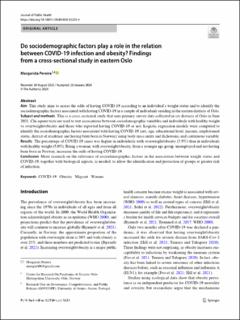| dc.contributor.author | Pereira, Margarida | |
| dc.date.accessioned | 2024-02-13T08:14:44Z | |
| dc.date.available | 2024-02-13T08:14:44Z | |
| dc.date.created | 2024-02-12T10:23:41Z | |
| dc.date.issued | 2024 | |
| dc.identifier.citation | Journal of Public Health (Berlin). 2024, . | en_US |
| dc.identifier.issn | 2198-1833 | |
| dc.identifier.uri | https://hdl.handle.net/11250/3117124 | |
| dc.description.abstract | Aim This study aims to assess the odds of having COVID-19 according to an individual’s weight status and to identify the sociodemographic factors associated with having COVID-19 in a sample of individuals residing in the eastern districts of Oslo. Subject and methods This is a cross-sectional study that uses primary survey data collected in six districts of Oslo in June 2021. Chi-square tests are used to test associations between sociodemographic variables and individuals with healthy weight vs overweight/obesity and those who reported having COVID-19 or not. Logistic regression models were computed to identify the sociodemographic factors associated with having COVID-19 (sex, age, educational level, income, employment status, district of residence and having been born in Norway) using body mass index and dichotomic and continuous variable. Results The percentage of COVID-19 cases was higher in individuals with overweight/obesity (5.9%) than in individuals with healthy weight (5.0%). Being a woman, with overweight/obesity, from a younger age group, unemployed and not having been born in Norway, increases the odds of having COVID-19. Conclusion More research on the relevance of sociodemographic factors in the association between weight status and COVID-19, together with biological aspects, is needed, to allow the identifcation and protection of groups at greater risk of infection. | en_US |
| dc.language.iso | eng | en_US |
| dc.rights | Navngivelse 4.0 Internasjonal | * |
| dc.rights.uri | http://creativecommons.org/licenses/by/4.0/deed.no | * |
| dc.title | Do sociodemographic factors play a role in the relation between COVID-19 infection and obesity? Findings from a cross-sectional study in eastern Oslo | en_US |
| dc.type | Peer reviewed | en_US |
| dc.type | Journal article | en_US |
| dc.description.version | publishedVersion | en_US |
| cristin.ispublished | true | |
| cristin.fulltext | original | |
| cristin.qualitycode | 1 | |
| dc.identifier.doi | https://doi.org/10.1007/s10389-024-02203-4 | |
| dc.identifier.cristin | 2245003 | |
| dc.source.journal | Journal of Public Health (Berlin) | en_US |
| dc.source.pagenumber | 9 | en_US |
| dc.relation.project | Norges forskningsråd: 302336 | en_US |

